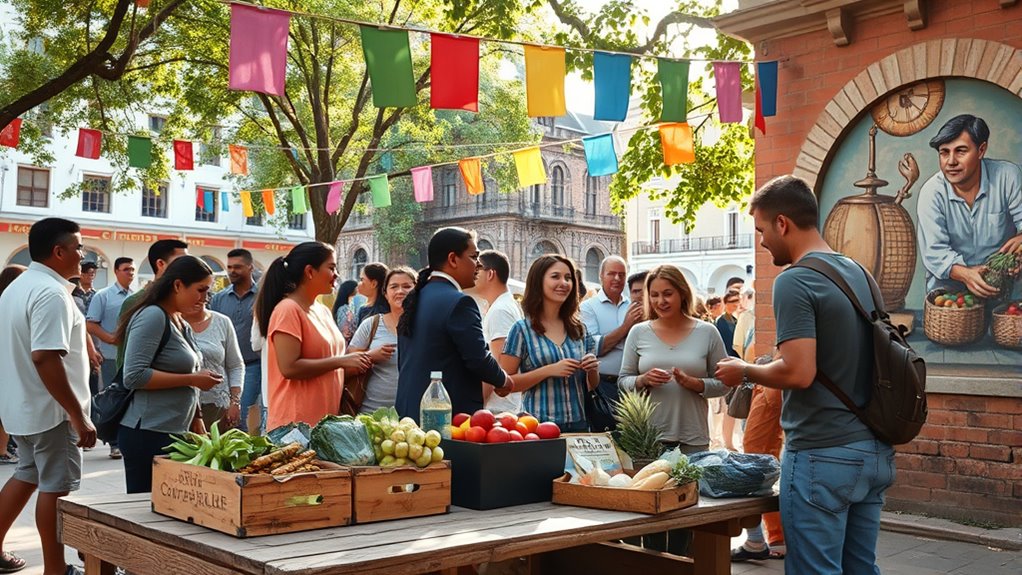Mutual aid networks have deep roots in community cooperation, dating back to ancient kinship ties and communal resource sharing. They flourished in the 19th and early 20th centuries through friendly societies and cooperative groups, then declined after World War II as government programs expanded. Today, they’re experiencing a strong revival, fueled by global crises and digital tools that strengthen local bonds and resilience. If you explore further, you’ll discover how these efforts continue to adapt and grow.
Key Takeaways
- Mutual aid originated in early communities relying on resource sharing and social bonds for survival, evolving into organized systems.
- 19th and early 20th-century mutual aid networks declined after government welfare programs expanded post-World War II.
- During crises, grassroots mutual aid groups provide emergency support, filling gaps in official response efforts.
- The modern revival leverages digital platforms for rapid community coordination and resource sharing.
- Contemporary mutual aid promotes urban sustainability, inclusivity, and resilience through innovative, community-driven initiatives.
Origins and Early Forms of Mutual Assistance
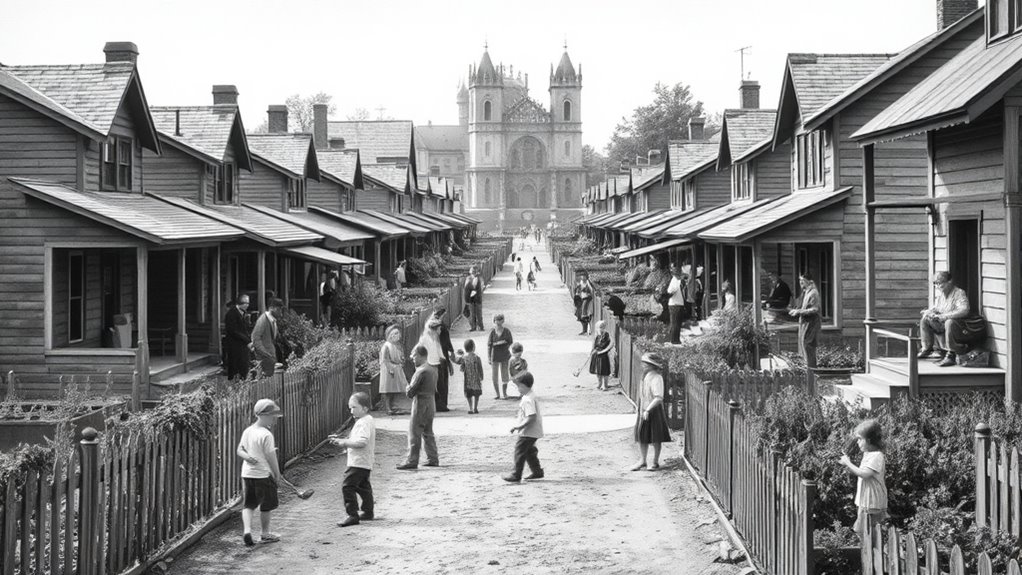
The roots of mutual aid networks trace back to early communities that relied on cooperation to survive and thrive. In these societies, mutual aid wasn’t just helpful—it was essential. People formed strong social bonds by sharing resources, supporting each other during hardships, and working together to meet common needs. These bonds created a sense of trust and collective responsibility, reinforcing the idea that everyone’s well-being depended on mutual support. Early forms of mutual aid often took the shape of kinship networks, communal labor, and resource sharing, which helped communities endure crises and adapt to challenges. By building social bonds through mutual aid, these communities laid the groundwork for more organized forms of assistance that would evolve over time. Recognizing the importance of social bonds promoted through collective effort, these networks fostered a sense of shared identity and purpose that remains relevant today. The enduring value of these early practices highlights how vital community cooperation was to their resilience and success. Furthermore, the development of organized mutual aid systems marked a significant evolution from informal support networks to more structured approaches to collective assistance.
Mutual Aid in the 19th and Early 20th Centuries

As industrialization and urbanization transformed societies during the 19th and early 20th centuries, mutual aid networks became essential for addressing new social and economic challenges. You saw communities forming around mutual aid philosophy, emphasizing collective support over individual reliance. These networks helped workers, immigrants, and marginalized groups access resources, social services, and protection against hardships. By participating, you actively contributed to social capital development, strengthening trust and cooperation among neighbors. Mutual aid during this period often took the form of friendly societies, cooperative associations, and mutual insurance plans. These initiatives fostered a sense of shared responsibility, empowering communities to face economic instability, health crises, and social upheavals together. This era laid the groundwork for modern mutual aid practices rooted in solidarity and collective resilience. Recognizing the importance of social cohesion, communities during this time prioritized building networks that could sustain collective well-being in times of crisis. Additionally, the development of community-based organizations played a crucial role in sustaining these networks and ensuring their longevity. The growth of these organizations contributed significantly to the development of social capital, which remains vital for community resilience today.
The Role of Mutual Aid During Major Crises
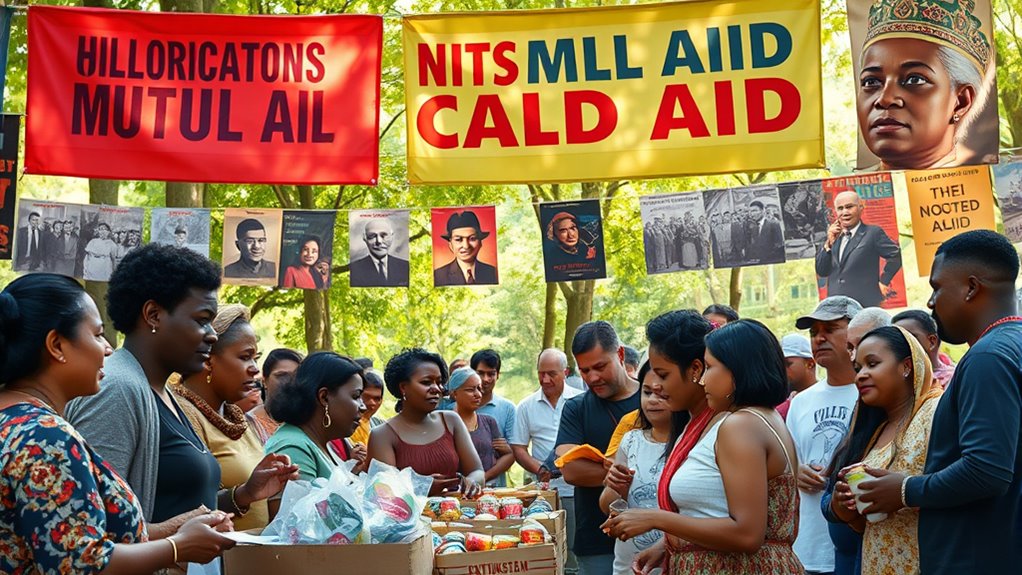
During major crises, mutual aid groups often step in as crucial emergency support systems, filling gaps left by official agencies. These efforts help build community resilience, empowering residents to recover and adapt quickly. Grassroots response efforts demonstrate how collective action can lead to effective, immediate relief in times of need. Empathetic support networks play a vital role in fostering trust and collaboration among community members during challenging times. Strengthening community bonds can further enhance the effectiveness of mutual aid initiatives in crisis situations.
Emergency Support Systems
How do mutual aid networks step up when major crises strike? They quickly mobilize to provide emergency support through well-organized volunteer coordination. These networks often rely on mutual aid funding to supply resources, such as food, medical supplies, and shelter. As chaos unfolds, volunteers coordinate efforts to reach affected communities efficiently, bypassing traditional systems that may be overwhelmed or delayed. This grassroots approach ensures immediate aid reaches those in need, filling gaps left by official agencies. Mutual aid groups adapt swiftly, leveraging local knowledge and community trust to maximize impact. Their ability to coordinate volunteers and allocate funds effectively makes them essential during crises, offering resilience and support when conventional systems falter. Additionally, their reliance on community-led initiatives enhances the overall effectiveness of emergency responses. Having experienced high rates of divorce, communities often develop stronger bonds and mutual support networks that can be mobilized during emergencies, further strengthening mutual aid efforts. The capacity to organize local resources efficiently is a vital component of their success.
Community Resilience Building
Mutual aid networks strengthen community resilience by empowering local residents to take collective action before, during, and after crises. By fostering local resource sharing, you can guarantee essential supplies and support reach those in need quickly. These networks build social capital, creating trust and stronger bonds within your community, which are indispensable during tough times. When challenges arise, your neighbors can mobilize resources, share skills, and provide emotional support, reducing dependence on external aid. This collective effort increases your community’s ability to adapt and recover efficiently. Self-watering planters exemplify innovative ways to maintain greenery with less frequent care, supporting community sustainability efforts. Understanding Ethical Hacking principles can also inspire innovative approaches to safeguarding community resources and information. Additionally, embracing community-based innovations, such as local exchange systems or shared tools, further enhances resilience and resourcefulness during crises. Recognizing the importance of essential oils and their properties can offer practical solutions for health and well-being support within communities during challenging times.
Grassroots Response Efforts
In the face of major crises, grassroots response efforts mobilize communities quickly to address urgent needs when external aid may be delayed or insufficient. Mutual aid networks become crucial tools in these moments, allowing neighbors to share resources, skills, and support without waiting for official assistance. These networks often operate through local groups that coordinate food, shelter, medical supplies, and emotional support. By acting swiftly and collaboratively, you help strengthen community resilience and ensure that vulnerable populations aren’t left behind. Mutual aid’s flexible, community-led approach proves indispensable during disasters, demonstrating the power of grassroots activism to foster immediate relief and long-term recovery. Understanding community resilience enhances the effectiveness of these networks during crises, as it emphasizes the importance of trust and cooperation within communities to sustain mutual aid efforts over time. Building community networks further amplifies the impact of mutual aid by creating a foundation of ongoing support and preparedness.
Decline and Transformation in the Post-War Era

Following World War II, many mutual aid networks experienced a significant decline as government social programs expanded and societal priorities shifted. Post-war austerity and cultural shifts led communities to rely more on state support rather than grassroots efforts. As governments introduced welfare and social insurance, the need for mutual aid diminished, and public trust in collective action changed. You might notice that:
- Communities focused more on individual success than collective care
- Government policies replaced informal support systems
- Mutual aid groups struggled to maintain relevance
- Economic recovery shifted priorities away from grassroots initiatives
This transformation reflects how societal and economic changes reshaped community support, moving away from traditional mutual aid networks toward formal institutions. Despite this decline, the foundational spirit persisted, waiting for a modern revival.
Resurgence in the 21st Century Amid Global Challenges
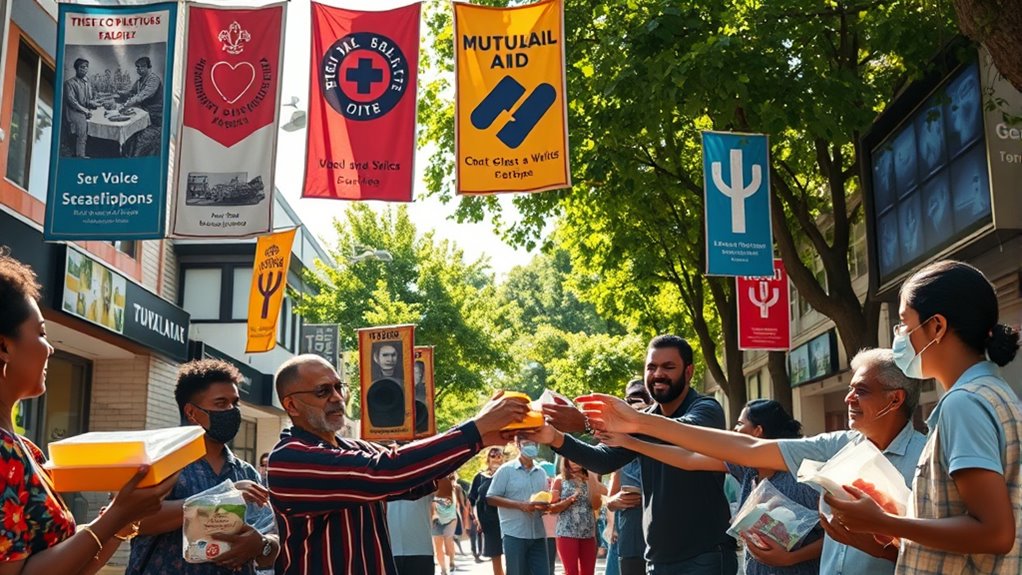
As global crises like climate change and economic instability intensify, you can see how mutual aid networks grow stronger and more essential. Digital platforms make it easier for communities to connect and coordinate support quickly. This resurgence reflects a powerful shift toward collective resilience in facing today’s challenges.
Community Resilience Growth
Community resilience has experienced a remarkable resurgence in the 21st century as global challenges like climate change, economic instability, and pandemics threaten traditional social structures. You notice communities turning inward, fostering local connections and self-sufficiency. Initiatives like urban gardening help neighborhoods grow their own food, reducing reliance on distant supply chains. Arts collectives bring people together through creative expression, strengthening bonds and shared identity. Mutual aid groups now coordinate efforts to support vulnerable populations during crises. These efforts promote a sense of empowerment and adaptability, essential in uncertain times. By nurturing local resources and networks, communities build resilience that withstands external shocks and promotes sustainable growth. This growth reflects a collective effort to thrive amid adversity, revitalizing the spirit of mutual aid.
Digital Platforms Expansion
The expansion of digital platforms in the 21st century has become a essential tool for strengthening mutual aid networks amid global challenges. You can now engage in virtual collaboration, connecting with others worldwide to coordinate efforts quickly and efficiently. Online resource sharing enables communities to distribute crucial information, supplies, and support without physical boundaries. Platforms like social media, dedicated apps, and online forums facilitate real-time communication, making mutual aid more accessible and responsive. This digital shift helps organize aid efforts, mobilize volunteers, and share best practices instantly. As a result, mutual aid networks become more resilient and adaptable, leveraging technology to meet urgent needs and foster collective action in ways that weren’t possible before.
Addressing Global Crises
Global crises in the 21st century, such as pandemics, climate change, and economic upheavals, have intensified the need for mutual aid networks to respond swiftly and effectively. You see, these networks embody mutual aid ethics, emphasizing community-driven solutions over reliance on government or corporations. They help mitigate the economic impact by providing immediate support and resource sharing during emergencies. As crises grow more complex, these networks adapt, fostering cooperation and resilience. They serve as essential safety nets, especially when traditional systems falter.
- Rapid response to health emergencies
- Climate disaster relief efforts
- Supporting vulnerable populations during economic downturns
- Strengthening community resilience worldwide
Contemporary Examples and Future Directions
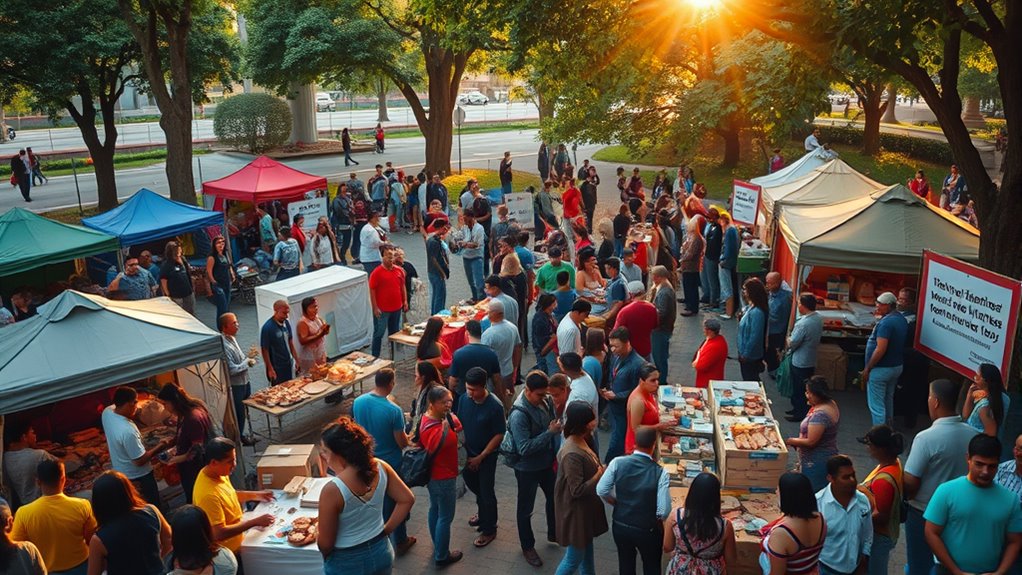
Contemporary mutual aid networks have gained momentum by leveraging digital platforms and social media to organize rapid, localized support in times of crisis. These networks foster urban sustainability by encouraging community-driven solutions that reduce reliance on centralized systems and promote resource sharing. They also celebrate cultural diversity, bringing together varied communities to address unique needs and strengthen social bonds. Moving forward, these networks are likely to expand through innovative technology, enhancing accessibility and inclusivity. As they evolve, they’ll continue to serve as indispensable tools for resilience, empowering communities to adapt to environmental challenges and social changes. By embracing digital tools and fostering inclusive participation, mutual aid networks will shape more sustainable and culturally rich urban environments.
Frequently Asked Questions
How Do Mutual Aid Networks Differ From Traditional Insurance Models?
Mutual aid networks differ from traditional insurance models because you actively participate in risk pooling, where members share costs and support each other. Unlike insurance companies that profit from premiums, your benefit distribution is based on collective support, not profit motives. You directly contribute and receive aid, fostering community resilience. This approach emphasizes mutual responsibility, transparency, and solidarity, making the process more equitable and adaptable to your needs.
What Cultural Factors Influenced the Development of Early Mutual Aid Societies?
You see, cultural traditions and community solidarity are the backbone of early mutual aid societies. These groups emerged because people believed in helping one another during tough times, rooted in shared customs and values. Cultural factors like religion, ethnicity, and local practices fostered trust and cooperation, proving that sometimes it takes a village to get through life’s hurdles. These influences shaped societies that prioritized collective well-being over individual gain.
How Have Digital Technologies Transformed Modern Mutual Aid Initiatives?
Digital platforms and online communities have revolutionized modern mutual aid initiatives by making organizing easier and more accessible. You can quickly connect with others, share resources, and coordinate efforts across distances, breaking down geographical barriers. These technologies foster real-time communication, amplify voices, and help you mobilize support efficiently. As a result, mutual aid becomes more inclusive and adaptable, empowering you to respond swiftly to community needs in a way that was impossible before digital tools.
What Challenges Do Mutual Aid Networks Face in Formal Legal Recognition?
You face legal barriers and regulatory challenges that can hinder mutual aid networks from gaining formal recognition. These obstacles might include zoning laws, licensing requirements, or restrictions on certain activities. Steering through complex regulations requires careful planning and advocacy. To succeed, you need to work with legal experts, engage policymakers, and demonstrate how your network benefits the community, helping to overcome these hurdles and achieve official status.
How Can Mutual Aid Networks Contribute to Social and Economic Resilience?
Did you know that communities with strong mutual aid networks can see a 30% increase in resilience during crises? You play a crucial role in fostering social and economic resilience by promoting community empowerment and resource sharing. Your involvement helps build support systems that adapt quickly to challenges, ensuring everyone benefits. By strengthening these networks, you’re creating a more resilient, connected community where resources are accessible, and collective well-being flourishes.
Conclusion
As you’ve seen, mutual aid networks are the heartbeat of community resilience, bouncing back like a phoenix from history’s ashes. Their revival today proves that, even in a world of rapid change, the spirit of mutual support remains a powerful force. By fostering connections and sharing resources, you become part of a living web that sustains us all. Together, you can turn challenges into opportunities, ensuring no one faces hardship alone.
